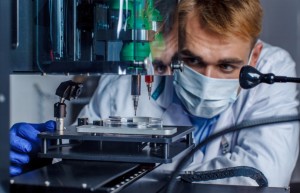
“Begin your journey with motivation so you end up an Inspiration.”
Motivation
“If I have seen further than others, it is by standing upon the shoulders of giants,” said Isaac Newton. I came across that quote one day when I was exploring a Calculus textbook, and right then it hit me deep. Much intrigued as I was, I set out to look for the giants of my era, to learn from them. Along this search, I still find many remarkable scientists and inventors who are working tirelessly in shaping the world, reforming it, making our lives better.
One such extraordinary personality is Dr. Anthony Atala, who is a surgeon and researcher. He’s the Chair of the Department of Urology at Wake Forest School of Medicine in North Carolina & the Director of the Wake Forest Institute for Regenerative Medicine where he carries out groundbreaking research-and-development work in the field of regenerative medicine.
Prior to my understanding of this, terms like tissue engineering, cells regeneration and organogenesis, were no more than science jargon. (And I assume, same is the case with many of you.)
Another widely cited name in the field is Dr. Gabor Forgacs, who is a theoretical physicist-cum-bioengineer and Founder of Organovo; a company that is most well-known in the industry. Its NovoGen MMX 3-D Bioprinter was named best invention of 2010 by TIME magazine.
The respective noteworthy contributions by these two inspiring individuals laid the foundation of contemporary Tissue Engineering field.
In his TED talk, in 2011, Dr. Atala amazed the world by demonstrating an undeniably-promising future of 3-D bioprinting. That same year, Dr. Forgacs also gave his TEDMED talk leading us to the futuristic applications like Organogenesis.
3-D Bioprinter
1)How does it work?
Widely regarded as novel technology in tissue engineering, 3-D bioprinting functions on somewhat same principles as any ordinary 3-D printer except that scientists may use a patch of your own body cells which after undergoing several chemical and thermal procedures can be scaled and used as ink in bioprinters. If that sounded even a tad bit insane to you, Dr. Forgacs is just the perfect man to show you the science behind. Watch his short yet wonderful demo here at TedMed.
2)Are they commercially available?
Industrially, the 3-D-Bioplotter is our best and safest bet that comes in two versions to match the needs of buyers. The high-end, Manufacturer Edition and a more accessible Developer Edition for academic and research institutions. Its price ranges up to $200,00 +, which shifts us ahead to BioBots, another best alternative. This company sells desktop bioprinters and bioinks in the range of $10,000 and $50; respectively
Who knows, you can design and develop your own bioprinter, maybe?
Deemed 3-D Bioprinting successes
– 3-D printed pelvic implantation for a teenage girl suffering from a type of bone cancer.
-a 54-year old woman is recovering in Tangdu Hospital in Xi’an, China, after doctors successfully implanted a 3-D printed titanium alloy sternum.
–Micro 3D Printing Middle Ear Prostheses for hearing loss sufferers.
-the highly acclaimed Printing a human Kidney- Dr. Anthony Atala.
That was just a preview. The internet is overflowing with medical 3-D printing juicy stories. Taste sometime.
And…
Add to the marvels of 3-D Bioprinter!
Wouldn’t it be amazing if you’d develop skin grafts for burn victims? or perhaps grow cartilage in lab to reconstruct body parts of patients, such as noses and ears. How wonderful it’d be if you’d develop liver, heart or kidney tissue prostheses to replace dysfunctional parts.
Suggesting Reading: Enter a new era of Science & Medicne with 3-D Bioprinting with Stem Cell
Skills you need to Acquire
Remember those professors forcing you to perform practicals in lab classes and how much you hated it. Well, that was for your own greater good. AutoCAD designing is a must-to-have-tool, no matter which engineering discipline you belong to. If you can convert your mental image of a concept into a prototype by 3-D designing, and run simulation. You’ve 1/2-achieved it!
The other half is the evaluation of how well you understand the biomaterial sciences. You must at least have some fundamental know-how of materials and their biocompatible properties. Most bioprinting technologies are syringe-based-extrusions that uses materials including-but-not-limited to hydrogels, hydroxypatite, silicone, titanium & chitosan.
From soft hydrogels, polymers up to hard ceramics and metals, gain in-depth understanding of the world of biomaterials and their interaction with human cells.
If you’re a hardcore biomedical engineer like me, you must be pulling all-nighters on Computational Fluid Dynamics, already. If not yet, then… what are you waiting for? Gear up and deal with Autodesk CFD here.
Challenges to overcome…
With any basic background in biology, certainly you understand that without blood vessels; nutrients, oxygen and wastes cannot diffuse throughout thick tissues, which leads to cell death. This is what they mean when they bring up Vascularization as a challenge in organ 3-D printing. So far, most of the 3-D printed tissues are avascular, hence very thin and unfit to generate large-scale tissues and organs.
Organogenesis isn’t entirely a far-fetched idea. It’s just a matter of time when we’ll achieve our ultimate goal of printing complex organs such as livers and kidneys for complete transplant by creating composite tissues made up of skin, muscle, tendon, nerves, bone and blood vessels.
In one of the interviews, inspirational Dr. Forgacs said these words which I’d like to conclude with:
“Dream, dream, dream! […] We live in a time when it is really difficult to say: “This is impossible!””



